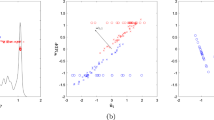Abstract
The data association problem consists of associating pieces of information emanating from different sources in order to obtain a better description of the situation under study. This problem arises, in particular, when, considering several sensors, we aim at associating the measures corresponding to a same target. This problem, widely studied in the literature, is often stated as a multidimensional assignment problem where a state criterion is optimized. While this approach seems satisfactory in simple situations where the risk of confusing targets is relatively low, it is much more difficult to get a correct description in denser situations. This is why, we propose, for the first time to our knowledge, to address this problem in a multiple criteria framework using a second complementary criterion, based on the identification of the targets. Due to the specificities of the problem, simple and efficient approaches can be used to generate non-dominated solutions. Moreover, we show that the accuracy of the proposed solutions is greatly increased when considering a second criterion. A bi-criteria interactive procedure is also introduced to assist an operator in solving conflicting situations.
Similar content being viewed by others
References
Bar-Shalom, Y. (Ed.) (1992). Multitarget-Multisensor Tracking: Advance Application Applications. Artech House: Norwood, Massachusetts.
Bar-Shalom, Y. and T.E. Fortmann. (1988). Tracking and Data Association. Academic Press: New-York.
Bar-Shalom, Y., T. Kirubarajan, and C. Gokberk. (2003). “Tracking with Classification-Aided Multiframe Data Association.” In Proceedings of SPIE, Signal and Data Processing of Small Targets, vol. 5204, pp. 131–142.
Bar-Shalom, Y. and X.R. Li. (1995). Multitarget-Multisensor Tracking: Principles and Techniques. Y. Bar-Shalom.
Bhatia, H.L., R. Malhotra, and M. Puri. (1982). “Bi-Criteria Assignment Problem.” Operations Research, 19(2), 84–96.
Blackman, S. and R. Popoli. (1999). Design and Analysis of Modern Tracking Systems. Artech House Radar Library Series.
Blair, W.D., G.A. Watson, T. Kirubarajan, and Y. Bar-Shalom. (1998). “Benchmark for Radar Allocation and Tracking in ECM.” IEEE Transactions on Aerospace and Electronic Systems, 34(4), 1097–1114.
Chankong, V. and Y.Y. Haimes. (1983). Multiobjective Decision Making. Elsevier Science Publishing: New York.
Deb, S., M. Yeddanapudi, K.R. Pattipati, and Y. Bar-Shalom. (1997). “A Generalized S-D Assignment Algorithm for Multisensor-Multitarget State Estimation.” IEEE Transactions on Aerospace and Electronic Systems, 33(2), 523–537.
Ehrgott, M. (2000). Multicriteria Optimization. Lecture Notes in Economics and Mathematical Systems. Springer-Verlag.
Ehrgott, M. and X. Gandibleux. (2000). “A Survey and Annoted Bibliography of Multiobjective Combinatorial Optimization.” OR Spektrum, 22, 425–460.
Gandibleux, X., H. Morita, and N. Katoh. (2003). “Population Based-Heuristic for Solving the Assignment Problems with Two Objectives.” Technical Report 7, LAMIH-ROI.
Garey, M. and D. Johnson. (1979). Computers and Intractability: A Guide to the Theory of NP-Completeness. Freeman and Co.: New York, San Fransico.
Hall, D.L. and J. Llinas. (1997). “An Introduction to Multisensor Data Fusion.” Proceedings of the IEEE, 85(1), 6–23.
Kirubarajan, T., Y. Bar-Shalom, and K.R. Pattipati. (2001). “Multiassignment for Tracking a Large Number of Overlapping Objects.” IEEE Transactions on Aerospace and Electronic Systems, 37(1), 2–21.
Kirubarajan, T., Y. Bar-Shalom, K.R. Pattipati, and I. Kadar. (2000). “Ground Target Tracking with Variable Structure IMM Estimator.” IEEE Transactions on Aerospace and Electronic Systems, 36(1), 2–21.
Morefield, C.R. (1977). “Application of 0-1 Integer Programming to Multitarget Tracking Problems.” IEEE Transactions on Automatic Control, 22(3), 302–312.
Neumayer, P. (1994). “Complexity of Optimization on Vectorweighted Graphs.” In A. Bachem, U. Derigs, M. Jünger, and R. Schrader (Eds.), Operations Research, Vol. 93, pp 359–361. Heidelberg, Physica Verlag.
Pattipati, K.R., S. Deb, Y. Bar-Shalom, and R.B. Washburn. (1992). “A New Relaxation Algorithm and Passive Sensor Data Association.” IEEE Transactions on Automatic Control, 37(2), 198–213.
Poore, A.B. (1994). “Multidimensional Assignment Formulation of Data Association Problems Arising from Multitarget and Multisensor Tracking.” Computational Optimization and Applications, 3, 27–57.
Poore, A.B. and N. Rijavec. (1994). “A Numerical Study of Some Data Association Problems Arising in Multitarget Tracking.” In W.W. Hager, D.W. Hearn, and P.M. Pardalos (Eds.), Large Scale Optimization: State of the Art, pp. 339–361.
Popp, R.L., K.R. Pattipati, and Y. Bar-Shalom. (2001). “m-Best S-D Assignment Algorithm with Application to Multitarget Tracking.” IEEE Transactions on Aerospace and Electronic Systems, 37(1), 22–37.
Serafini, P. (1986). “Some Considerations About Computational Complexity for Multiobjective Combinatorial Problems.” In J. Jahn and W. Krabs (Eds.), Recent Advances and Historical Development of Vector Optimization, Vol. 294, of Lecture Notes in Economics and Mathematical Systems, pp. 222–232. Berlin, Springer-Verlag.
Sevgi, L., A. Ponsford, and H.C. Chan. (2001). “An Integrated Maritime Surveillance System Based on High-Frequency Surface-Wave Radars.” IEEE Antennas and Propagation Magazine, 43(4), 52–63.
Tuyttens, D., J. Teghem, P. Fortemps, and K.V. Nieuwenhuyze. (2000). “Performance of the MOSA Method for the Bicriteria Assignment problem.” Journal of Heuristics, 6(3), 295–310.
Ulungu, E. and J. Teghem. (1994). “The Two-Phases Method: An Efficient Procedure to Solve Bi-Objective Combinatorial Optimization Problems.” Foundations of Computing and Decision Sciences, 20(2), 149–165.
Wang, H., T. Kirubarajan, and Y. Bar-Shalom. (1999). “Precision Large Scale Air Traffic Surveillance Using IMM with Assignment Estimators.” IEEE Transactions on Aerospace and Electronic Systems, 35(1), 225–266.
Author information
Authors and Affiliations
Corresponding author
Rights and permissions
About this article
Cite this article
Hugot, H., Vanderpooten, D. & Vanpeperstraete, J.M. A bi-criteria approach for the data association problem. Ann Oper Res 147, 217–234 (2006). https://doi.org/10.1007/s10479-006-0069-9
Published:
Issue Date:
DOI: https://doi.org/10.1007/s10479-006-0069-9




